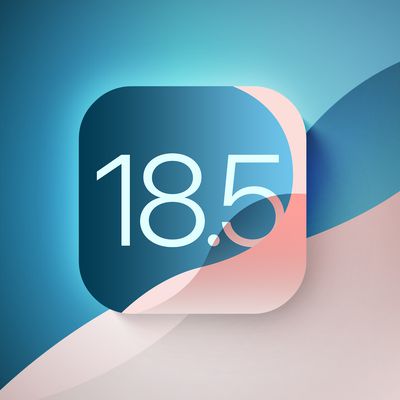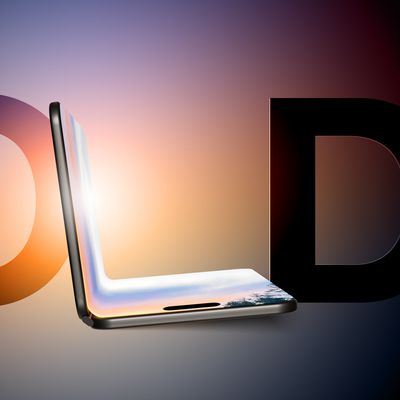At its September special event in 2021, Apple introduced the Apple Watch Series 7. The Series 7 replaces the Apple Watch Series 6, which was announced in September of 2020, as the company's flagship wearable.

The Apple Watch Series 7 offers a number of upgrades and improvements on 2020's Series 6, offering a larger display with bigger casing sizes, faster charging, and the S7 chip, for a price starting at $399.
Although the Apple Watch Series 6 has now been discontinued by Apple, it continues to be available at many third-party resellers. If you already have an Apple Watch Series 6, you may be wondering if it is worth upgrading to the Series 7. You may also be using an older Apple Watch and are looking to upgrade, but cannot decide if you should buy the Series 6 or the Series 7. Alternatively, you may be wondering if it is better to buy the lower-cost Series 6 when looking for your first Apple Watch.
As these two models share many key features, including ECG functionality, blood oxygen monitoring, and an always-on display, it may not be immediately obvious which model is better for you. Is it worth purchasing or sticking with the slightly older model with fewer features to save money? Our guide helps you to answer the question of which of these two Apple Watch models is best for you.
Comparing Apple Watch Series 6 and Apple Watch Series 7
With just one year between them as flagship smartwatches, the Apple Watch Series 6 and Series 7 share most of their important features. Apple lists these identical aspects of the two models:
Similarities
- Aluminum, Stainless Steel, and Titanium models with Ion-X glass or sapphire crystal
- Digital Crown with haptic feedback
- Always-On Retina LTPO OLED display with up to 1,000 nits max brightness
- "Swimproof" water resistance up to 50 meters
- 64-bit dual-core processor, W3 wireless chip, and U1 Ultra Wideband chip
- 50 percent louder speaker than Apple Watch Series 3
- Built-in microphone
- Blood oxygen sensor
- Electrical heart sensor for ECG
- Third-generation optical heart sensor, high and low heart rate notifications, and irregular heart rhythm notifications
- Ambient light sensor
- Accelerometer and gyroscope with fall detection
- Compass and always-on altimeter
- GPS/GNSS, GLONASS, Galileo, QZSS, and Beidou
- GPS and GPS + Cellular models
- Wi-Fi 802.11 b/g/n and Bluetooth 5.0
- Family Setup support
- 18-hour "all-day" battery life
- 32GB of storage
- Graphite, Silver, and Gold stainless steel finishes, Silver and Space Black titanium finishes, and Blue and PRODUCT(RED) aluminum options
Apple's breakdown shows that the two models share an overwhelming majority of features. Even so, there are a number of important differences between the Series 6 and the Series 7 that are worth highlighting, such as casing sizes, fast charging, and color options.
Differences
- 40mm and 44mm case sizes
- 3.0mm borders
- S6 chip
- Up to 100 percent charge in just 1.5 hours
- Space Gray, Silver, Gold, Blue, and (PRODUCT)RED aluminum color options
- 30.5g/36.4g (Aluminum), 39.7g/47.1g (Stainless Steel), and 34.6g/41.3g (Titanium)
- 1m USB-C Magnetic Charging Cable
- 41mm and 45mm case sizes
- 1.7mm borders for almost 20 percent more screen area than Series 6
- Up to 70 percent brighter display than Series 6 indoors when wrist is down
- Crack-resistant front crystal
- IP6X dust resistance
- S7 chip
- Fast charging: Up to 80 percent charge in about 45 minutes (33 percent faster than Series 6)
- Midnight, Starlight, Green, Blue, and (PRODUCT)RED aluminum color options
- 32.0g/38.8g (Aluminum), 42.3g/51.5g (Stainless Steel), and 37.0g/45.1g (Titanium)
- 1m USB-C Magnetic Fast Charging Cable
Read on for a closer look at each of these aspects, and see what exactly both of the most recent Apple Watch models have to offer.
Design
Although the Apple Watch Series 6 and Series 7 share a similar design, the Apple Watch Series 7's case actually features a new design with softer, more rounded corners. There is only one speaker grille on the left of the device and the overall look has been slightly refined.

The display of the Apple Watch Series 7 has a refractive edge that curves around the top of the device, allowing full-screen watch faces and apps to almost reach the casing.
The casings of the Apple Watch Series 7 are also physically larger, offering 41mm and 45mm models. This is a 1mm increase over the Series 6's 40mm and 44mm casing sizes. All of the Apple Watch Series 7 models are also heavier than their Series 6 predecessors, which could make the weight difference when switching from an aluminum to a stainless steel model even more pronounced.
The two Apple Watch generations feature a range of different finishes and color options. While the stainless steel and titanium finishes are the same across both generations, the aluminum casings have an almost completely different set of color options.
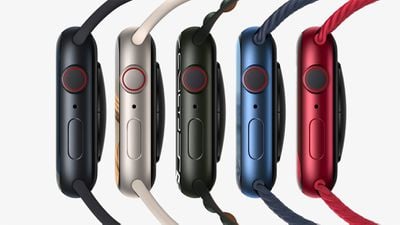
The Apple Watch Series 6 offered Space Gray, Silver, Gold, Blue, and (PRODUCT)RED aluminum color options, while the Apple Watch Series 7 is available in Midnight, Starlight, Green, Blue, and (PRODUCT)RED aluminum color options.
If you were particularly attached to a Space Gray, Silver, or Gold aluminum Apple Watch Series 6, you will have to consider what different color you would want with the Apple Watch Series 7. While it may not influence which of the two models you would buy as a first Apple Watch or upgrading from an older model, the different color options are still a noteworthy consideration.
Durability
The Apple Watch Series 7 is more durable than the Series 6, espousing more crack-resistant front crystal. The new crystal component has a more robust geometry and is over 50 percent thicker than that of the Apple Watch Series 6.
The Apple Watch Series 7 is also certified as IP6X dust-resistant, making it more durable for environments such as the beach or the desert. The Series 7, like the Series 6, continues to be "swimproof" with water resistance up to 50 meters deep.
While the improved durability is unlikely to singularly motivate purchases of the Series 7, it could be an important factor for users who often frequent dusty or sandy environments, or have been prone to cracking their watch in the past.
Displays
Display size is one of the most significant differences between the Apple Watch Series 6 and Apple Watch Series 7. The Series 6 features borders around its display that are 3.0mm thick, but the Series 7 slims these down to just 1.7mm. With larger casing sizes, the Series 7 features larger displays that have almost 20 percent more screen area than on the Series 6.
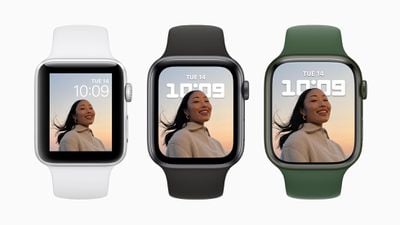 The display of the Apple Watch Series 3 (left), Series 6 (middle), and Series 7 (right)
The display of the Apple Watch Series 3 (left), Series 6 (middle), and Series 7 (right)The larger display of the Apple Watch Series 7 models allows it to show more content and Apple has optimized watchOS 8 to take advantage of the additional space with larger menu titles and buttons in apps. There are two additional larger font sizes and a new QWERTY keyboard that can be tapped or swiped with QuickPath.

The Apple Watch Series 7 also features two exclusive watch faces, designed to showcase the larger displays and reduced borders. The new Contour face brings the animated dial right to the edge of the display and emphasizes the current hour. The new Modular Duo face leverages the additional screen space with two large center complications.
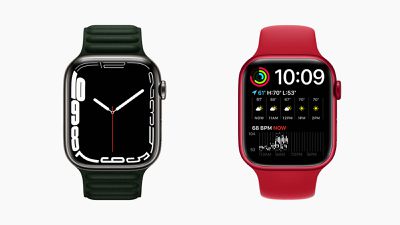 The Contour and Modular Duo exclusive watch faces
The Contour and Modular Duo exclusive watch facesBoth the Apple Watch Series 6 and Apple Watch Series 7 come with a Retina LTPO OLED display. While the maximum brightness of both displays is the same at 1,000 nits, the Series 7's display is up to 70 percent brighter indoors when the wrist is lowered than that of Apple Watch Series 6, making it easier to see the watch face without having to raise the wrist or wake the display.
The Series 6's display will be more than adequate for a good Apple Watch experience, but the Series 7 simply elevates watchOS with more space for UI elements and the likes of a full-sized keyboard. If you have longed for a bigger Apple Watch display, the Series 7 could be a much better option than the Series 6, but for most users, the increase is likely too inconsequential to justify upgrading.
S6 vs. S7 Chip
The Apple Watch Series 7 is powered by the S7 chip, which is based around the same CPU found in the S6 chip from the Apple Watch Series 6. Such is the similarity between the chips that both CPUs have the same identifier.
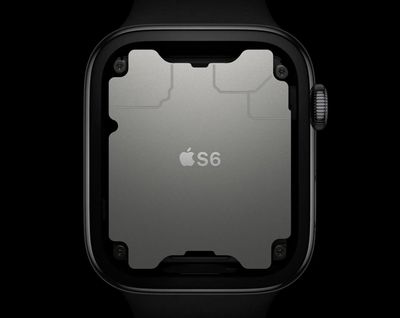
Apple says that both the S6 and S7 chip provide a 20 percent performance improvement over the S5 chip in the Apple Watch Series 5 and Apple Watch SE, indicating that they have equivalent performance.
The changes in the S7 chip generally relate to smaller tweaks to maintain the same "all-day" battery life with a larger display. Apple has done this before with the S5 chip, which had the same CPU as the S4 chip, simply adding a gyroscope.
The S7 chip is not a good reason to upgrade to the Apple Watch Series 7, representing a small iterative improvement rather than any noticeable performance or efficiency boost.
Charging
The Apple Watch Series 7 features 33 percent faster charging than the Series 6 due to a new charging architecture. The Apple Watch Series 6 is able to charge up to 100 percent in an hour and a half, but the Series 7 can reach 80 percent in just 45 minutes.
According to Apple, just eight minutes of charging time can provide eight hours of sleep tracking with the Series 7. This is partly thanks to a new USB-C magnetic fast charging cable that is included with the Apple Watch Series 7 in the box.
If you find that you have little time to charge your Apple Watch during the day, the Series 7's faster charging could be an important reason to upgrade for you. Even so, both devices still have the same "all-day" 18-hour battery life and will need to be recharged every day.
Other Apple Watch Options
Apple also offers the Apple Watch SE for $279. This model has fewer features than the Apple Watch Series 6, but is a lower-cost option with many of the aspects that have made the Apple Watch so popular over the years. The Apple Watch SE does not have an always-on display, ECG, or blood oxygen monitoring, but it does contain the same S5 chip as the Series 5 and the same always-on altimeter as the Series 6.
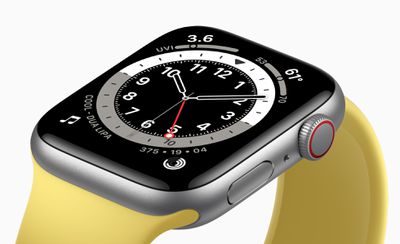
If you were already siding with the Apple Watch Series 6, it may be worth exploring the lower-cost Apple Watch SE. If you are looking for the most out of your Apple Watch and are particularly interested in health-monitoring features, the Apple Watch SE may not be suitable.
For a more specific breakdown of the Apple Watch Series 6 versus the Apple Watch SE, take a look at our handy Apple Watch Series 6 vs. Apple Watch SE buyer's guide.
There is also the Apple Watch Series 3, which Apple sells for $199. This older model offers substantially fewer features and has a smaller screen. The Apple Watch Series 3 is still a capable device, with 8GB of storage, water-resistance up to 50 meters, an altimeter, Emergency SOS, and an optical heart sensor. Functionally, it is more pared back than the Apple Watch SE, being thicker with larger bezels.
The Apple Watch Series 3 is really only intended for those who want an Apple Watch at the lowest possible price, but it will certainly be the least future-proof model. Given that the Apple Watch Series 3 is a much older model, if you can afford an Apple Watch Series 6 or Apple Watch Series 7, you should definitely prefer those newer options.
- Apple Watch SE vs. Apple Watch Series 7 Buyer's Guide
- Apple Watch SE vs. Apple Watch Series 3 Buyer's Guide
- Apple Watch Series 5 vs. Series 6 Buyer’s Guide
- Apple Watch Series 6 vs. Apple Watch SE Buyer's Guide
Final Thoughts
Overall, the Apple Watch Series 7 is a minor upgrade over the Apple Watch Series 6, offering larger displays and casing sizes, new color options, improved durability, the S7 chip, and faster charging. These features are mostly iterative improvements rather than major reasons to upgrade, and the Series 7 does not add any new functionality.

For Users of Older Devices or Those New to Apple Watch...
Getting the latest device may be a more important consideration for those who upgrade their Apple Watch infrequently and the Series 7 clearly offers bigger upgrades to those coming from older devices. For those who have an Apple Watch Series 5 or older, or those who are new to Apple Watch entirely, the Apple Watch Series 7 is a good option with plenty of new features to justify upgrading.
If you are on a budget and are not particularly attracted to the additional features of the Series 7, the Apple Watch Series 6 remains an option worth considering if you can get it for a good enough price. It shares many features with the newer model, such as the ability to take ECGs and monitor blood oxygen, but it should still be remembered that the Series 6 is already over a year old, and may not support software updates for as long as the Series 7.
For Apple Watch Series 6 Users...
For users who already have an Apple Watch Series 6, the Series 7 probably does not offer enough to warrant upgrading unless you particularly want a larger display, faster charging, or improved durability. The design changes and new features are iterative rather than transformative, and there are no new major capabilities, so many Series 6 users may prefer to wait a little longer to upgrade.
With its larger display and more refined design, the Apple Watch Series 7 will be the model of choice for those that want the most out of their wearable. As Apple's newest flagship Apple Watch, customers who buy the Series 7 will not be excluded from anything the Apple Watch has to offer.







